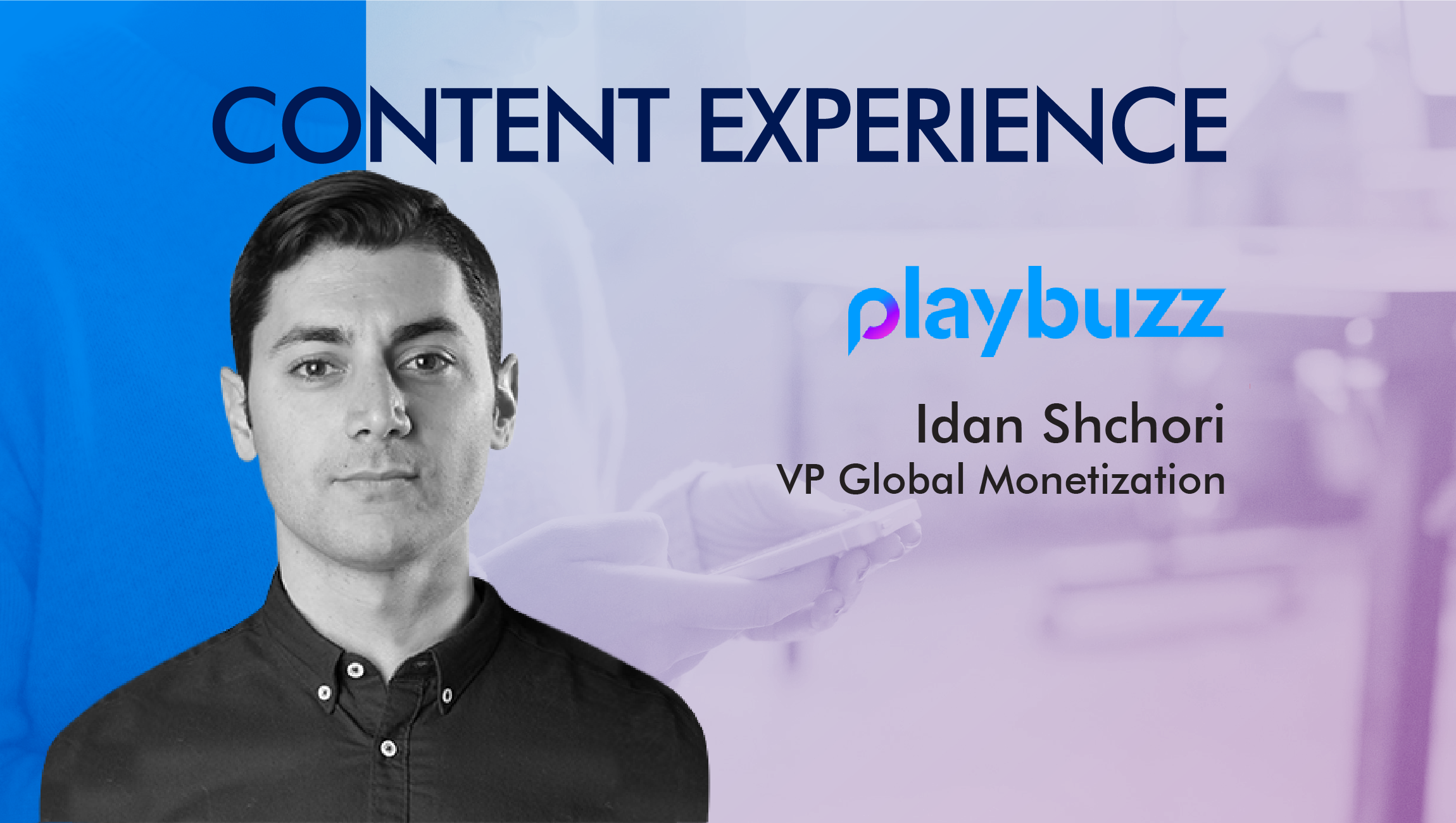Idan Shchori
VP Global Monetization, Playbuzz
In 2018, there are immense opportunities for marketers to monetize their content. Global marketers have successfully built their content empires by sticking to one major goal — deliver relevant, interactive, and personalized content to customers. Playbuzz is a successful authoring platform for storytellers, and to understand how they bring core monetization offerings to global publishers and brands/agencies, we spoke to their VP, Global Monetization, Idan Shchori.
Html code here! Replace this with any non empty text and that's it.
Tell us about your role at Playbuzz, and the team and technology you handle.
As VP of Monetization, I oversee Playbuzz’s revenue pillars which bring the interactivity of our storytelling tools, to various ad offerings we are rolling out globally. The main goal of my team is to enable our direct publisher partners to drive revenue.
Premium publishers such as ABC, ESPN, HuffPost, BBC and more utilize the Playbuzz platform to create interactive editorial in order to drive audience engagement. In the simplest of terms – we help them monetize that editorial, as well as connect them with top brands who would like to advertise on their website in order to reach their target audiences.
In addition, we have conceptualized and produced innovative forms of advertising that put content and the reader’s journey first as we believe that users should not have to tolerate ads, but instead be compelled to engage with them.
What are your core monetization offerings to global publishers and brands/agencies?
Our monetization offerings span from long-form, interactive articles that brands utilize to natively advertise on publishers’ sites, as well as branded elements that are relevant to the editorial they are placed in. We are committed to quality, which is why these campaigns attract 99% human, non-fraudulent traffic as confirmed by White Ops. Our offerings include:
- Branded Campaigns: We produce long-form, interactive narratives via our storytelling platform and distribute them at scale to relevant publishers whom already utilize our editorial tools. These campaigns have achieved an average CTR of 4.6+% and an average 86% brand lift, as reported by Nielsen. In the past year, we have produced such campaign for brands including Netflix, Unilever, Shell and more.
- Branded Elements: Earlier this year we began rolling out our latest monetization offering – ad units that take the interactivity of our storytelling tools, while natively blending into editorial, so users have a positive reading experience sans pop-ups or dull static banners.
- Ad Serving: Using our in-house ad serving technology, we can monetize the interactive stories our publisher partners create with the Playbuzz platform. This includes instream video advertising – utilizing our own video storytelling tools – which complies with Google’s Ad Exchange policies. My team ensures we get as granular as possible in regard to hypertargeting needs of brands in order to successfully reach their desired audiences in our network of publishers.
The results of these offerings speak for themselves: We are ranked #7 in comScore’s Lifestyles Category and #27 in the company’s list of Top 100 Video Properties based on our high-quality, broad distribution of interactive native ads. Not to mention, Playbuzz-powered campaigns garner metrics high above industry standards, such as an average of 97%+ in-item viewability confirmed by MOAT and 2-4 minute average session times (as compared to the 15 second industry average).
Also Read: Interview with Shachar Orren, Chief Storyteller, Playbuzz
Which content experience technologies are you keenly following? How do you leverage that research for creating better storytelling tools at Playbuzz?
Today’s readers spend an average of 15 seconds or less on a piece of content, meaning it’s crucial publishers start experimenting with how to harness their increasingly decreasing attention spans. Thus, I am focused on any consumption experience that involves the user. Today, readers want to flip, tap, swipe, and vote. Though many have incorporated such opportunities into editorial, it should be applied to monetization as well.
In addition, I’m a proponent of ad experiences that are relevant to the user. Content and monetization must go hand-in-hand – the more contextual native ads are to the stories a reader has clicked on, the more engaging and more successful your monetization efforts will be.
If advertisers continue to push out meaningless, irrelevant ads, it will only fuel the existing fire of widespread content fatigue.
Tell us the key differences between your Monetization offerings compared to others in the market?
At Playbuzz, we choose to put our partners first – publishers and advertisers alike. Our #1 priority is to promote the creation of visually-stunning, interactive and data-driven content to align with today’s content consumption habits. By putting our vision of what content should be above everything, and by applying that to our monetization strategy, we have been able to enter the market with unique ad products focused on interactivity.
That network of thousands of publishers worldwide utilizing our tools, also sets us apart as we are able to connect them with brands who are seeking space to place their campaigns.
At Playbuzz, how do you balance the art of Creative Marketing and the science of Data Management and analytics?
Data goes hand-in-hand with our offering as our partners must know how their content is performing in order to optimize future content based on their audience’s behavior. Our data tool, Playbuzz Analytics, provides publishers and brands with a breakdown of their content’s performance in real-time. This includes in-article engagements, drop off rates, completion rates, top-performing elements within an article, insights based on performance and more.
We see this tool as crucial. The media environment continues to shift and publishers must do away with archaic metrics such as clicks, and instead focus on engagement-based KPIs that truly showcase whether or not someone had a meaningful consumption experience with their content.
We make sure to communicate the ability to see such data in our platform to our partners, whether that be through email marketing, face-to-face conversations, our social channels, or within the press.
How should content monetization platforms better leverage AI/ML capabilities for relevant, personalized media buying and streaming?
Personalization is key as it makes users’ consumption experience feel unique to them. Of course, Facebook and Google know this well.
Making users’ feeds as customized to them as possible will drive increased eyeballs, dwell time and thus, the ability to better monetize. In 2018, you shouldn’t be offering apples to someone who prefers oranges.
What are your predictions for customer experience platforms and ad campaign performance tools in 2018?
I foresee much more demand coming from advertisers and simultaneously, more restrictions that promote a more quality consumption experience.
GDPR came from users, not from advertisers. Though it’s being met with some hesitation, I believe it serves as quality control and an opportunity to genuinely improve online advertising as it will enhance the personalized experience for consumers. The same can be said for Google implementing ad blocking in Chrome on February 15 for those publishers who refuse to uphold more elevated ad standards.
Thanks for chatting with us, Idan.
Stay tuned for more insights on marketing technologies. To participate in our Tech Bytes program, email us at news@martechseries-67ee47.ingress-bonde.easywp.com











